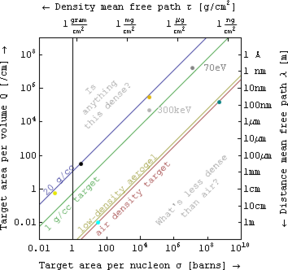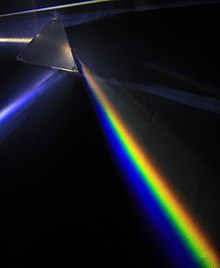From Wikipedia, the free encyclopedia
| Light-year | |
|---|---|
| Unit system | astronomical units |
| Unit of | length |
| Symbol | ly |
| Unit conversions | |
| 1 ly in ... | ... is equal to ... |
| metric (SI) units | 9.4607×1015 m |
| imperial & US units | 5.8786×1012 mi |
| astronomical units | 6.3241×104 au 0.3066 pc |
The light-year is most often used when expressing distances to stars and other distances on a galactic scale, especially in non-specialist and popular science publications. The unit usually used in professional astrometry is the parsec (symbol: pc, approximately 3.26 light-years; the distance at which one astronomical unit subtends an angle of one second of arc).[1]
Definitions
As defined by the IAU, the light-year is the product of the Julian year[note 2] (365.25 days as opposed to the 365.2425-day Gregorian year) and the speed of light (299792458 m/s).[note 3] Both these values are included in the IAU (1976) System of Astronomical Constants, used since 1984.[3] From this the following conversions can be derived.1 light-year = 9460730472580800 metres (exactly) ≈ 9.461 petametres ≈ 5.878625 trillion miles ≈ 63241.077 astronomical units ≈ 0.306601 parsecs
Other high-precision values are not derived from a coherent IAU system. A value of 9.460536207×1015 m found in some modern sources[10][11] is the product of a mean Gregorian year (365.2425 days or 31556952 s) and the defined speed of light (299792458 m/s). Another value, 9.460528405×1015 m,[12][13] is the product of the J1900.0 mean tropical year and the defined speed of light.
History
The light-year unit appeared a few years after the first successful measurement of the distance to a star other than our Sun, by Friedrich Bessel in 1838. The star was 61 Cygni, and he used a 6.2-inch (160 mm) heliometer designed by Joseph von Fraunhofer. The largest unit for expressing distances across space at that time was the astronomical unit, equal to the radius of the Earth's orbit (1.50×108 km or 9.30×107 mi). In those terms, trigonometric calculations based on 61 Cygni's parallax of 0.314 arcseconds, showed the distance to the star to be 660000 astronomical units (9.9×1013 km or 6.1×1013 mi). Bessel added that light employs 10.3 years to traverse this distance.[14] He recognized that his readers would enjoy the mental picture of the approximate transit time for light, but he refrained from using the light-year as a unit. He may have resented expressing distances in light-years because it would deteriorate the accuracy of his parallax data due to multiplying with the uncertain parameter of the speed of light. The speed of light was not yet precisely known in 1838; its value changed in 1849 (Fizeau) and 1862 (Foucault). It was not yet considered to be a fundamental constant of nature, and the propagation of light through the aether or space was still enigmatic. The light-year unit appeared, however, in 1851 in a German popular astronomical article by Otto Ule.[15] The paradox of a distance unit name ending on year was explained by Ule by comparing it to a hiking road hour (Wegstunde). A contemporary German popular astronomical book also noticed that light-year is an odd name.[16] In 1868 an English journal labelled the light-year as a unit used by the Germans.[17] Eddington called the light-year an inconvenvient and irrelevant unit, which had sometimes crept from popular use into technical investigations.[18]Although modern astronomers often prefer to use the parsec, light years are also popularly used to gauge the expanses of interstellar and intergalactic space.
Usage of term
Distances expressed in light-years include those between stars in the same general area, such as those belonging to the same spiral arm or globular cluster. Galaxies themselves span from a few thousand to a few hundred thousand light-years in diameter, and are separated from neighbouring galaxies and galaxy clusters by millions of light-years. Distances to objects such as quasars and the Sloan Great Wall run up into the billions of light-years.| Scale (ly) | Value | Item |
|---|---|---|
| 10−9 | 40.4×10−9 ly | Reflected sunlight from the Moon's surface takes 1.2–1.3 seconds to travel the distance to the Earth's surface (travelling roughly 350000 to 400000 kilometres). |
| 10−6 | 15.8×10−6 ly | One astronomical unit (the distance from the Sun to the Earth). It takes approximately 499 seconds (8.32 minutes) for light to travel this distance.[19] |
| 127×10−6 ly | The Huygens probe lands on Titan off Saturn and transmits images from its surface 1.2 billion kilometres to the Earth. | |
| 10−3 | 2.04×10−3 ly | The most distant space probe, Voyager 1, was about 18 light-hours away from the Earth as of October 2014[update].[20] It will take about 17500 years to reach one light-year (1.0×100 ly) at its current speed of about 17 km/s (38000 mph) relative to the Sun. On September 12, 2013, NASA scientists announced that Voyager 1 had entered the interstellar medium of space on August 25, 2012, becoming the first manmade object to leave the Solar System.[21] |
| 100 | 1.6×100 ly | The Oort cloud is approximately two light-years in diameter. Its inner boundary is speculated to be at 50000 AU, with its outer edge at 100000 au. |
| 2.0×100 ly | Maximum extent of the Sun's gravitational dominance (Hill sphere/Roche sphere, 125000 AU). Beyond this is the deep ex-solar gravitational interstellar medium. | |
| 4.22×100 ly | The nearest known star (other than our Sun), Proxima Centauri, is about 4.22 light-years away.[22][23] | |
| 8.60×100 ly | Sirius, the brightest star of the night sky. Twice as massive and 25 times more luminous than the Sun, it outshines more luminous stars due to its relative proximity. | |
| 11.90×100 ly | HD 10700 e, an extrasolar candidate for a habitable planet. 6.6 times as massive as the earth, it is in the middle of the habitable zone of star Tau Ceti.[24][25] | |
| 20.5×100 ly | Gliese 581, a red-dwarf star with several detectable exoplanets. | |
| 310×100 ly | Canopus, second in brightness in the terrestrial sky only to Sirius, a type F supergiant 15000 times more luminous than the Sun. | |
| 103 | 26×103 ly | The centre of our galaxy, the Milky Way, is about 26 kilolight-years away.[26][27] |
| 100×103 ly | The Milky Way is about 100000 light-years across. | |
| 165×103 ly | R136a1, in the Large Magellanic Cloud, the most luminous star known at 8.7 million times the luminosity of the Sun, has an apparent magnitude 12.77, just brighter than 3C 273. | |
| 106 | 2.5×106 ly | The Andromeda Galaxy is approximately 2.5 megalight-years away. |
| 3×106 ly | The Triangulum Galaxy (M33), at about 3 megalight-years away, is the most distant object visible to the naked eye. | |
| 59×106 ly | The nearest large galaxy cluster, the Virgo Cluster, is about 59 megalight-years away. | |
| 150×106 – 250×106 ly | The Great Attractor lies at a distance of somewhere between 150 and 250 megalight-years (the latter being the most recent estimate). | |
| 109 | 1.2×109 ly | The Sloan Great Wall (not to be confused with Great Wall and Her–CrB GW) has been measured to be approximately one gigalight-year distant. |
| 2.4×109 ly | 3C 273, optically the brightest quasar, of apparent magnitude 12.9, just dimmer than R136a1. | |
| 45.7×109 ly | The comoving distance from the Earth to the edge of the visible universe is about 45.7 gigalight-years in any direction; this is the comoving radius of the observable universe. This is larger than the age of the universe dictated by the cosmic background radiation; see size of the universe: misconceptions for why this is possible. |
Related units
Distances between objects within a star system tend to be small fractions of a light year, and are usually expressed in astronomical units. However, smaller units of length can similarly be formed usefully by multiplying units of time by the speed of light. For example, the light-second, useful in astronomy, telecommunications and relativistic physics, is exactly 299792458 metres or 1⁄31557600 of a light-year. Units such as the light-minute, light-hour and light-day are sometimes used in popular science publications. The light-month, roughly one-twelfth of a light-year, is also used occasionally for approximate measures.[28][29] The Hayden Planetarium specifies the light month more precisely as 30 days of light travel time.[30]Metric prefixes are occasionally applied to the light-year. Thus one thousand, one million and one billion light-years are sometimes called a "kilolight-year", a "megalight-year" and a "gigalight-year" (abbreviated "kly", "Mly" and "Gly") respectively.
Light travels approximately one foot in a nanosecond; the term "light-foot" is sometimes used as an informal measure of time.




